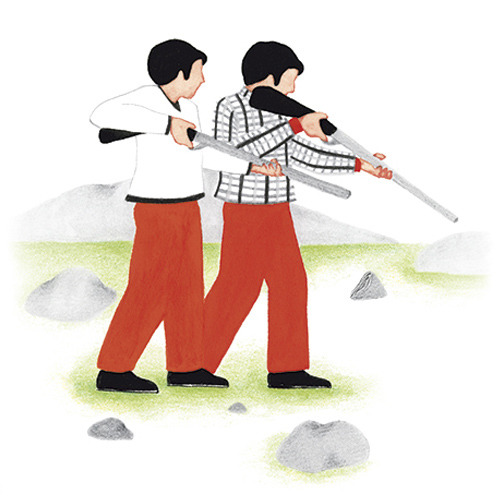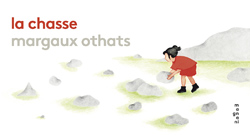< Back to posts
Margaux Othats
France

Margaux Othats studied Illustration at the School of Decorative Arts in Strasbourg. Since graduating, she's created illustrations for numerous publications including Nyctalope, Kiblind and The New York Times. Margaux's debut picturebook, ‘La Chasse’ was nominated for The Picture Book Prize at the Montreuil Children's Book Fair.
In this post, Margaux talks about ‘La Chasse’ (The Hunt). This powerful wordless picturebook about courage, perseverance and emancipation was created by Margaux for a graduation project at college, and is published by Éditions Magnani in France.
Margaux: ‘La Chasse’ (The Hunt) was one of my graduation projects at the School of Decorative Arts in Strasbourg. During my five years at the school I worked on other books, but this book remains my most accomplished and important. It represents both the end of my life as a student and my first step into the publishing world. That's why I'm very attached to it.
The book was born from a drawing in a sketchbook. My stories are often born that way. I regularly draw images that appear in my mind – most often in gouache – and these are not necessarily formal studies or sketches, but rather autonomous images. As the sketchbook gets filled, ideas get repeated, intersect and interact with each other, and end up creating several narrative paths.
‘La Chasse’ started from the image of a little girl amongst broken rocks and hunters.
The rocks were broken. So what could they have represented a few minutes before?
What was the little girl doing before the hunters arrived?
The story was created by associating ideas. Hunters hunt animals, so the rocks could represent animals. The fragments look like pieces of a sculpture, so the rocks could be sculptures of animals made by the little girl, etc.
Here's another image from my sketchbook which shows a fox jumping on some hunters. The attacker being attacked.
So I now had my plot and the ending of the story: A sculpture which the hunters destroy like a sand castle, a little girl who gathers up the pieces of rock and makes animals that get bigger and bigger... until she builds a wolf or a fox that will leap on the hunters.
The link between the story and the book as an object is something that interests me a lot. During my studies, I spent six months at the school's ‘Book-Object’ workshop to learn bookbinding and to reflect on ‘the object’. I like the idea that the manipulation of the book as an object goes hand in hand with what's going on – that the format, the weight, the paper have as much influence in telling the story as the images and the text. Correspondingly, I wanted the character of the physical book to be very formal, and I had the image of an animal that leaps... so I thought that the book's pages could unfold to follow the animal's movement.
Initially, I thought the last pages of the book would be the ones that would unfold. But then I combined this idea with another one I had of using an Italian format (the pages opening vertically), and presenting the characters on the bottom pages, using the system in a repetitive way. So when the wolf arrives, the illustration comes out of its fixed frame and spreads over both pages.
This is a story about emancipation. The emancipation of the little girl and the sculpture, but also of the linear rhythm of the story, or of the drawing on the page. This system is very much present in the book, in the layout of the pages, but also in how the story unfolds. The hunters destroy, the little girl rebuilds, the hunters destroy again...
It's as if there's a melody which continues until the final crescendo.
Repetition is an aspect that recurs a lot in what I do. The story can be just one action, which is repeated until the turnaround of the situation at the end. There are no real events; the reader quickly understands how the story goes. The attention can then be led somewhere else: towards contemplating a gesture – in this case, of building and destroying. I like the image of time that is stretched. A slow gesture where the action is prolonged.
Also, any embellishment in the illustrations is reduced to a minimum; there are few details, and the characters are there just for the gesture. This can seem a bit barren, but I believe that it's this minimalistic side that also brings a notion of silence that I give a lot of importance to.
When I started thinking about this book, it was obvious that there wouldn't be any text. This wasn't a wish to be different or a constraint imposed by myself. In the story the characters do not interact with one another, there is no dialogue, and the action could be summarised in one sentence without any need for explanation.
It was really a matter of silence. I had the very utopian wish that, through the absence of text, within the silence, one could imagine the sounds, the shots, the rocks breaking...
There is also something fascinating about not guiding the reading of the book, and leaving all the possible interpretations up to the reader. There are no good or bad interpretations.
This is something that surprised me a lot when the book came out. The way in which each person made the story his or her own. This is perfectly illustrated by this Marcel Duchamp quote: ‘It's the viewer who makes the work’.
Of course, I have my own interpretation of the story, but I like the idea that each reader may have one that is a bit different. Actually, I had a feeling that the book didn't belong to me any more the moment it got into other people's hands. It was very exciting.
Illustrations © Margaux Othats. Post translated by Gengo and edited by dPICTUS.
La Chasse / The Hunt
Margaux Othats
Éditions Magnani, France, 2015
A little girl is building an animal with rocks. Hunters arrive and destroy it. She builds a new one. But the same thing happens. Again and again. Until the little girl creates an animal too big and powerful for the hunters to destroy.














